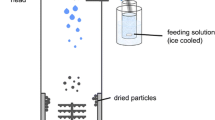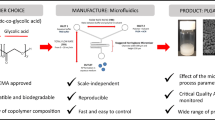Abstract
The preparation of nano-sized carrier systems increasingly moved into focus of pharmaceutical research and industry in the past decades. Besides the drug load and properties of the selected polymer/lipid, the size of such particles is one of the most important parameters regarding their use as efficient drug delivery systems. However, the preparation of nanoparticles with different sizes in a controlled manner is challenging, especially in terms of reproducibility and scale-up possibility. To overcome these hurdles we developed a system relying on nanoprecipitation, which meets all these requirements of an operator independent, scalable and size-adjustable nanoparticle synthesis—the Semi-Automated Nanoprecipitation-System. This system enables the adaption of the particle size to specific needs based on the process parameters—injection rate, flow rate and polymer concentration—identified within this study. The basic set-up is composed of a syringe pump and a gear pump for a precise control of the flow and injection speed of the system. Furthermore, a home-made tube-straightener guarantees a curvature-free injection point. Thus it could be shown that the production of poly(lactide-co-glycolide) nanoparticles from 150 to 600 nm with a narrow size distribution in a controlled semi-automatic manner is possible.


Similar content being viewed by others
Abbreviations
- DLS:
-
Dynamic light scattering
- DMSO:
-
Dimethyl sulfoxide
- FR:
-
Flow rate
- IP:
-
Injection position
- IR:
-
Injection rate
- PDI:
-
Polydispersity index
- PLGA:
-
Poly(lactide-co-glycolide)
- PVA:
-
Polyvinyl alcohol
- SAN-System:
-
Semi-Automated Nanoprecipitation-System
- SEM:
-
Scanning electron microscopy
References
Allen TM, Cullis PR. Drug delivery systems: entering the mainstream. Science. 2004;303:1818–22.
Kammona O, Kiparissides C. Recent advances in nanocarrier-based mucosal delivery of biomolecules. J Control Release. 2012;161:781–94.
Goeran L, Hubert R, Gert R, Birgit S-K, Peter G, Jean-Philippe P, et al. Considerations on a definition of nanomaterial for regulatory purposes. Publications Office of the European Union; 2010.
Davis ME, Chen ZG, Shin DM. Nanoparticle therapeutics: an emerging treatment modality for cancer. Nat Rev Drug Discov. Nature Publishing Group. 2008;7:771–82.
Soppimath KS, Aminabhavi TM, Kulkarni AR, Rudzinski WE. Biodegradable polymeric nanoparticles as drug delivery devices. J Control Release. 2001;70:1–20.
Des Rieux A, Fievez V, Garinot M, Schneider Y-J, Préat V. Nanoparticles as potential oral delivery systems of proteins and vaccines: a mechanistic approach. J Control Release. 2006;116:1–27.
Swaminathan J, Ehrhardt C. Liposomal delivery of proteins and peptides. London: Informa UK Ltd; 2012.
Fessi H, Puisieux F, Devissaguet JP, Ammoury N, Benita S. Nanocapsule formation by interfacial polymer deposition following solvent displacement. Int J Pharm. 1989;55:R1–4.
Beck-Broichsitter M, Rytting E, Lebhardt T, Wang X, Kissel T. Preparation of nanoparticles by solvent displacement for drug delivery: a shift in the “ouzo region” upon drug loading. Eur J Pharm Sci. 2010;41:244–53.
François G, Katz JL. Nanoparticles and nanocapsules created using the Ouzo effect: spontaneous emulisification as an alternative to ultrasonic and high-shear devices. ChemPhysChem. 2005;6:209–16.
Quintanar-Guerrero D, Allémann E, Doelker E, Fessi H. Preparation and characterization of nanocapsules from preformed polymers by a new process based on emulsification-diffusion technique. Pharm Res. Kluwer Academic Publishers-Plenum Publishers. 1998;15:1056–62.
Mora-Huertas CE, Fessi H, Elaissari A. Polymer-based nanocapsules for drug delivery. Int J Pharm. Elsevier Science BV, PO Box 211, 1000 AE Amsterdam, Netherlands. 2010;385:113–42.
Xie H, Smith JW. Fabrication of PLGA nanoparticles with a fluidic nanoprecipitation system. J Nanobiotechnol. 2010;8:18.
Guan X, Martonen TB. Simulations of flow in curved tubes. Aerosol Sci Technol. Taylor & Francis. 1997;26:485–504.
Avila K, Moxey D, de Lozar A, Avila M, Barkley D, Hof B. The onset of turbulence in pipe flow. Science. 2011;333:192–6.
Keck CM, Müller RH. Photonenkorrelationsspektroskopie. Mod Pharm Technol. 2009;56–60.
Plasari E, Grisoni PH, Villermaux J. Influence of process parameters on the precipitation of organic nanoparticles by drowning-out. Chem Eng Res Des. 1997;75:237–44.
Chorny M, Fishbein I, Danenberg HD, Golomb G. Lipophilic drug loaded nanospheres prepared by nanoprecipitation: effect of formulation variables on size, drug recovery and release kinetics. J Control Release. 2002;83:389–400.
ACKNOWLEDGMENTS AND DISCLOSURES
This work was supported by grants from the BMBF (funding code: 13N11454) in PeTrA project “Plattform für effizienten epithelialen Transport für pharmazeutische Applikationen durch innovative partikuläre Trägersysteme”. Dr. Chiara De Rossi is thanked for technical assistance with preparing the SEM images.
René Rietscher and Carolin Thum contributed equally to this work.
Author information
Authors and Affiliations
Corresponding author
Rights and permissions
About this article
Cite this article
Rietscher, R., Thum, C., Lehr, CM. et al. Semi-Automated Nanoprecipitation-System—An Option for Operator Independent, Scalable and Size Adjustable Nanoparticle Synthesis. Pharm Res 32, 1859–1863 (2015). https://doi.org/10.1007/s11095-014-1612-z
Received:
Accepted:
Published:
Issue Date:
DOI: https://doi.org/10.1007/s11095-014-1612-z




